Unit 3: Supporting the Individual Journey via Integrated Health
VerifiedAdded on 2023/06/10
|18
|6859
|266
Report
AI Summary
This report examines integrated health and social care, focusing on supporting individuals through coordinated services. It outlines local resources and provisions, addressing unmet needs in health, care, and support services. The report differentiates between healthcare and social care providers, emphasizing inter-agency collaboration for meeting individual needs. It evaluates local resources in the context of multidisciplinary care and explores the role of healthcare practitioners in promoting person-centered care. Furthermore, it discusses leadership in inter-professional teams, information sharing responsibilities, and personal development in supporting integrated care access. The report also covers communication methods for supporting individuals, applying appropriate communication strategies, and analyzing the capacity for person-centered risk-taking. The importance of safe and effective communication within professional boundaries is highlighted, along with facilitating the communication of changing care needs. This assignment provides insights into enhancing patient care through better service coordination and addressing gaps in the system, with Desklib offering additional resources for students.
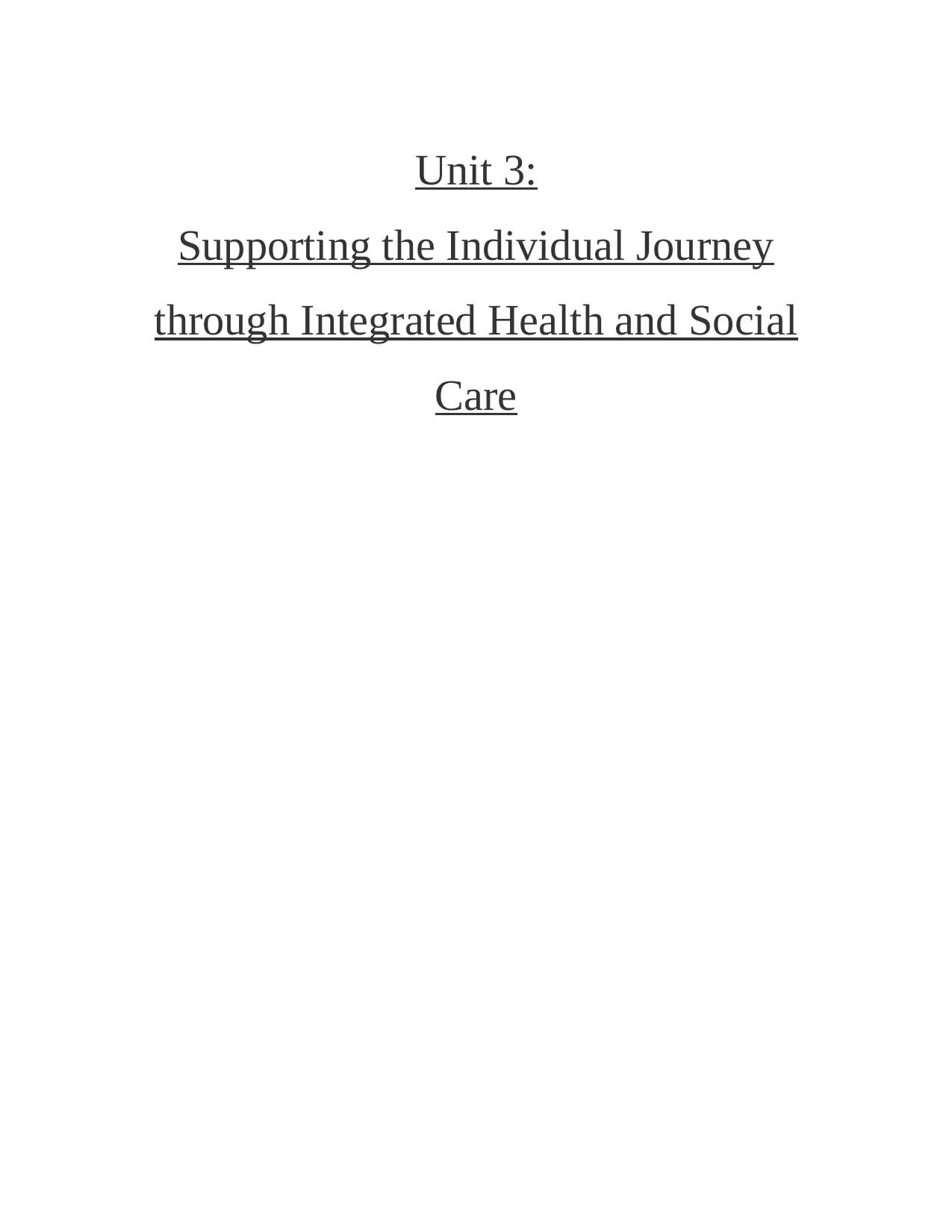
Unit 3:
Supporting the Individual Journey
through Integrated Health and Social
Care
Supporting the Individual Journey
through Integrated Health and Social
Care
Paraphrase This Document
Need a fresh take? Get an instant paraphrase of this document with our AI Paraphraser
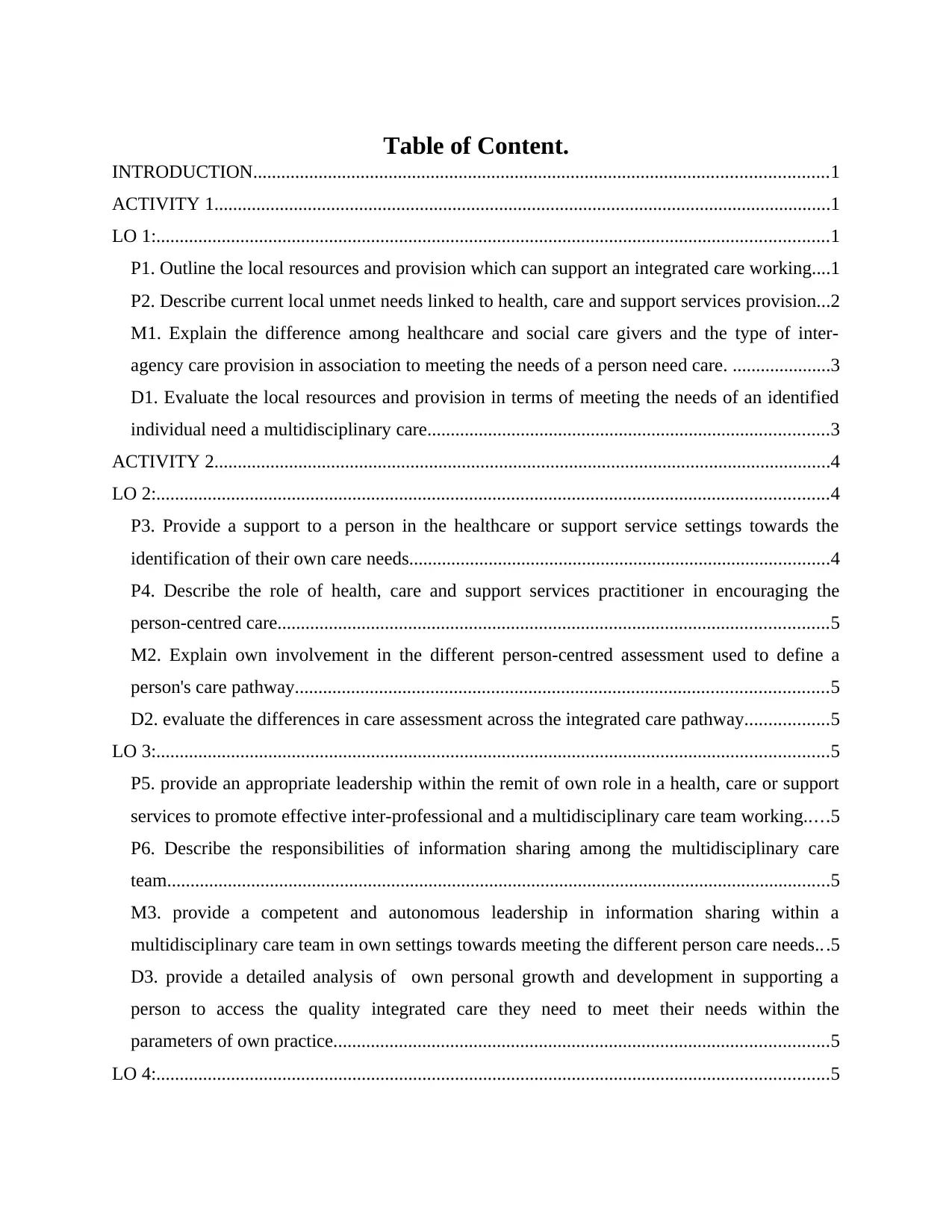
Table of Content.
INTRODUCTION...........................................................................................................................1
ACTIVITY 1....................................................................................................................................1
LO 1:................................................................................................................................................1
P1. Outline the local resources and provision which can support an integrated care working....1
P2. Describe current local unmet needs linked to health, care and support services provision...2
M1. Explain the difference among healthcare and social care givers and the type of inter-
agency care provision in association to meeting the needs of a person need care. .....................3
D1. Evaluate the local resources and provision in terms of meeting the needs of an identified
individual need a multidisciplinary care......................................................................................3
ACTIVITY 2....................................................................................................................................4
LO 2:................................................................................................................................................4
P3. Provide a support to a person in the healthcare or support service settings towards the
identification of their own care needs..........................................................................................4
P4. Describe the role of health, care and support services practitioner in encouraging the
person-centred care......................................................................................................................5
M2. Explain own involvement in the different person-centred assessment used to define a
person's care pathway..................................................................................................................5
D2. evaluate the differences in care assessment across the integrated care pathway..................5
LO 3:................................................................................................................................................5
P5. provide an appropriate leadership within the remit of own role in a health, care or support
services to promote effective inter-professional and a multidisciplinary care team working.....5
P6. Describe the responsibilities of information sharing among the multidisciplinary care
team..............................................................................................................................................5
M3. provide a competent and autonomous leadership in information sharing within a
multidisciplinary care team in own settings towards meeting the different person care needs...5
D3. provide a detailed analysis of own personal growth and development in supporting a
person to access the quality integrated care they need to meet their needs within the
parameters of own practice..........................................................................................................5
LO 4:................................................................................................................................................5
INTRODUCTION...........................................................................................................................1
ACTIVITY 1....................................................................................................................................1
LO 1:................................................................................................................................................1
P1. Outline the local resources and provision which can support an integrated care working....1
P2. Describe current local unmet needs linked to health, care and support services provision...2
M1. Explain the difference among healthcare and social care givers and the type of inter-
agency care provision in association to meeting the needs of a person need care. .....................3
D1. Evaluate the local resources and provision in terms of meeting the needs of an identified
individual need a multidisciplinary care......................................................................................3
ACTIVITY 2....................................................................................................................................4
LO 2:................................................................................................................................................4
P3. Provide a support to a person in the healthcare or support service settings towards the
identification of their own care needs..........................................................................................4
P4. Describe the role of health, care and support services practitioner in encouraging the
person-centred care......................................................................................................................5
M2. Explain own involvement in the different person-centred assessment used to define a
person's care pathway..................................................................................................................5
D2. evaluate the differences in care assessment across the integrated care pathway..................5
LO 3:................................................................................................................................................5
P5. provide an appropriate leadership within the remit of own role in a health, care or support
services to promote effective inter-professional and a multidisciplinary care team working.....5
P6. Describe the responsibilities of information sharing among the multidisciplinary care
team..............................................................................................................................................5
M3. provide a competent and autonomous leadership in information sharing within a
multidisciplinary care team in own settings towards meeting the different person care needs...5
D3. provide a detailed analysis of own personal growth and development in supporting a
person to access the quality integrated care they need to meet their needs within the
parameters of own practice..........................................................................................................5
LO 4:................................................................................................................................................5
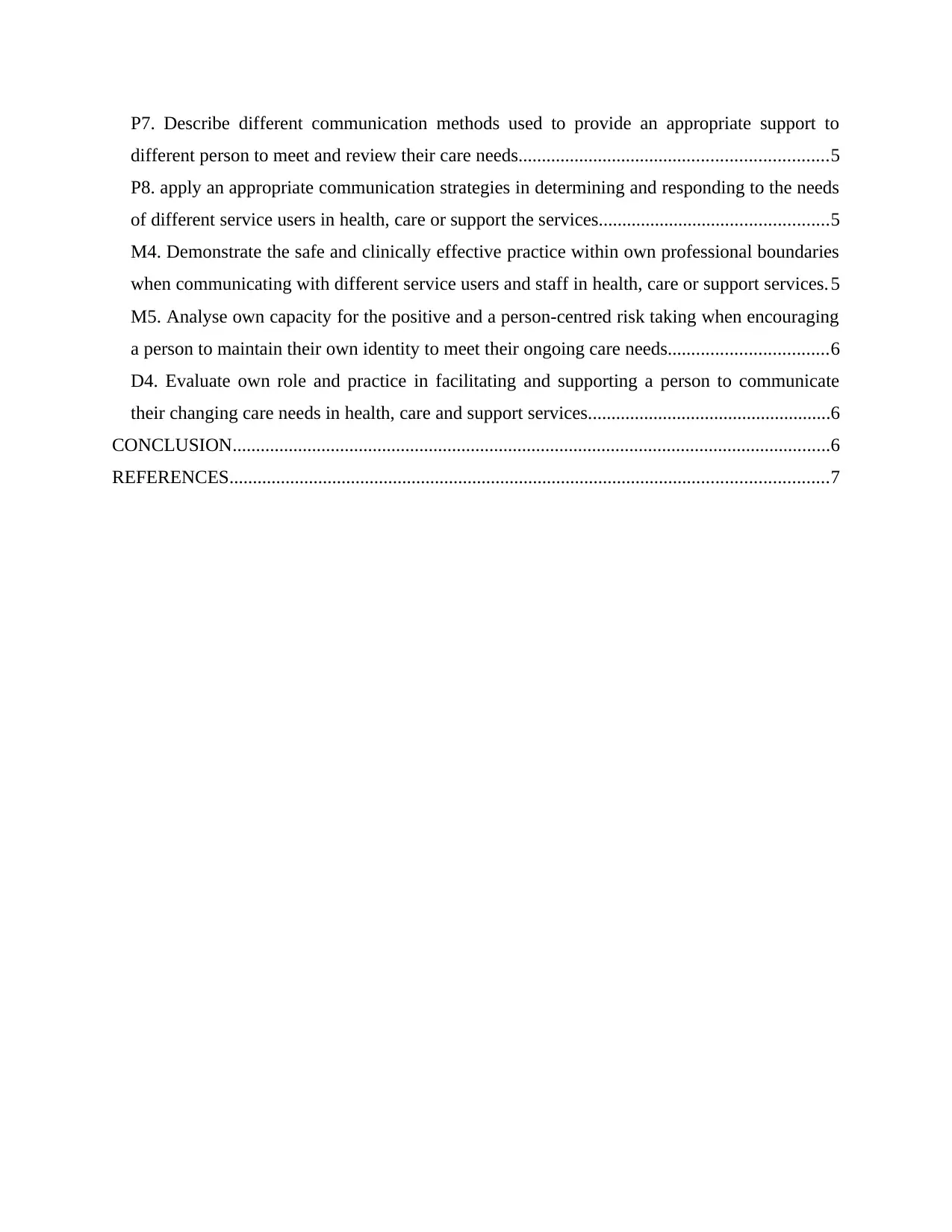
P7. Describe different communication methods used to provide an appropriate support to
different person to meet and review their care needs..................................................................5
P8. apply an appropriate communication strategies in determining and responding to the needs
of different service users in health, care or support the services.................................................5
M4. Demonstrate the safe and clinically effective practice within own professional boundaries
when communicating with different service users and staff in health, care or support services. 5
M5. Analyse own capacity for the positive and a person-centred risk taking when encouraging
a person to maintain their own identity to meet their ongoing care needs..................................6
D4. Evaluate own role and practice in facilitating and supporting a person to communicate
their changing care needs in health, care and support services....................................................6
CONCLUSION................................................................................................................................6
REFERENCES................................................................................................................................7
different person to meet and review their care needs..................................................................5
P8. apply an appropriate communication strategies in determining and responding to the needs
of different service users in health, care or support the services.................................................5
M4. Demonstrate the safe and clinically effective practice within own professional boundaries
when communicating with different service users and staff in health, care or support services. 5
M5. Analyse own capacity for the positive and a person-centred risk taking when encouraging
a person to maintain their own identity to meet their ongoing care needs..................................6
D4. Evaluate own role and practice in facilitating and supporting a person to communicate
their changing care needs in health, care and support services....................................................6
CONCLUSION................................................................................................................................6
REFERENCES................................................................................................................................7
⊘ This is a preview!⊘
Do you want full access?
Subscribe today to unlock all pages.

Trusted by 1+ million students worldwide
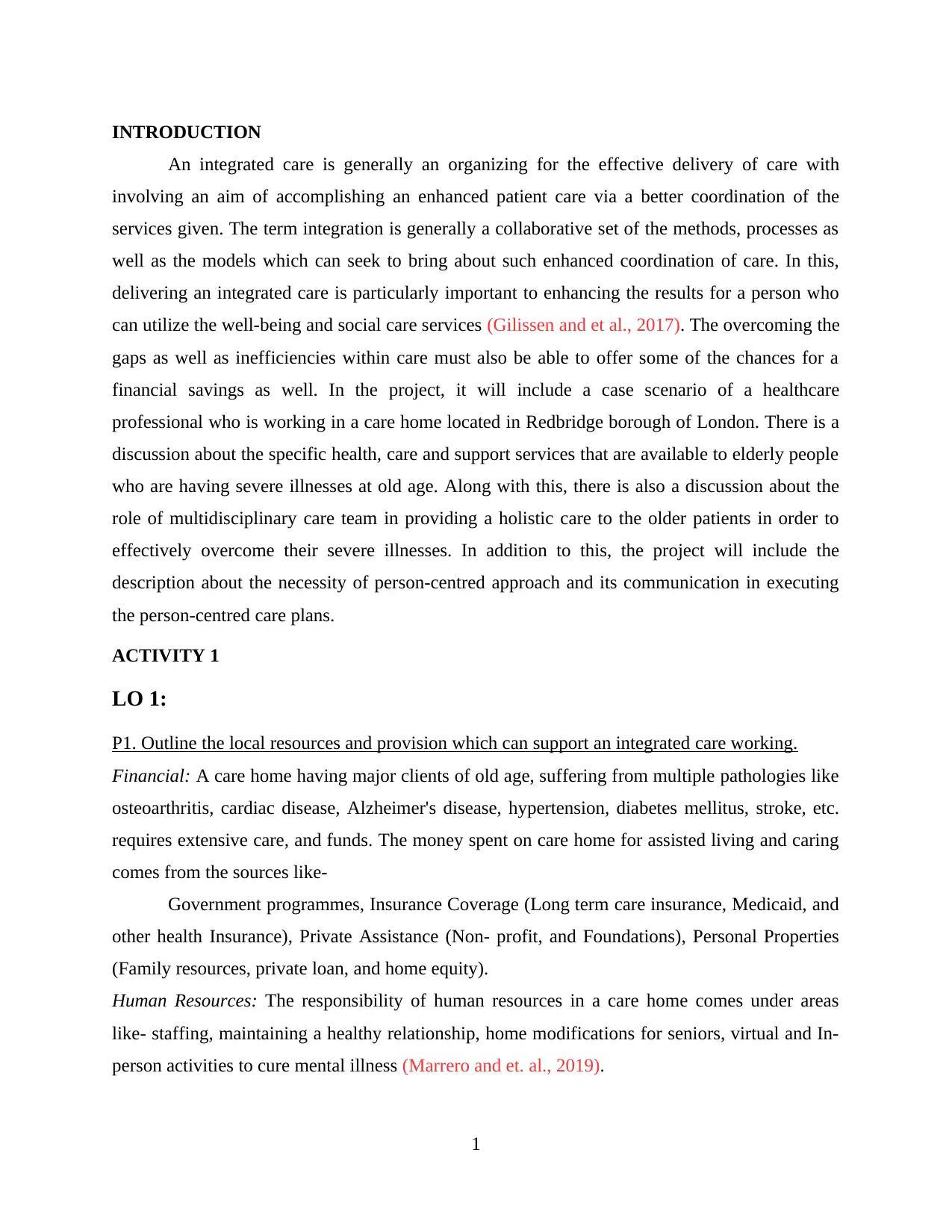
INTRODUCTION
An integrated care is generally an organizing for the effective delivery of care with
involving an aim of accomplishing an enhanced patient care via a better coordination of the
services given. The term integration is generally a collaborative set of the methods, processes as
well as the models which can seek to bring about such enhanced coordination of care. In this,
delivering an integrated care is particularly important to enhancing the results for a person who
can utilize the well-being and social care services (Gilissen and et al., 2017). The overcoming the
gaps as well as inefficiencies within care must also be able to offer some of the chances for a
financial savings as well. In the project, it will include a case scenario of a healthcare
professional who is working in a care home located in Redbridge borough of London. There is a
discussion about the specific health, care and support services that are available to elderly people
who are having severe illnesses at old age. Along with this, there is also a discussion about the
role of multidisciplinary care team in providing a holistic care to the older patients in order to
effectively overcome their severe illnesses. In addition to this, the project will include the
description about the necessity of person-centred approach and its communication in executing
the person-centred care plans.
ACTIVITY 1
LO 1:
P1. Outline the local resources and provision which can support an integrated care working.
Financial: A care home having major clients of old age, suffering from multiple pathologies like
osteoarthritis, cardiac disease, Alzheimer's disease, hypertension, diabetes mellitus, stroke, etc.
requires extensive care, and funds. The money spent on care home for assisted living and caring
comes from the sources like-
Government programmes, Insurance Coverage (Long term care insurance, Medicaid, and
other health Insurance), Private Assistance (Non- profit, and Foundations), Personal Properties
(Family resources, private loan, and home equity).
Human Resources: The responsibility of human resources in a care home comes under areas
like- staffing, maintaining a healthy relationship, home modifications for seniors, virtual and In-
person activities to cure mental illness (Marrero and et. al., 2019).
1
An integrated care is generally an organizing for the effective delivery of care with
involving an aim of accomplishing an enhanced patient care via a better coordination of the
services given. The term integration is generally a collaborative set of the methods, processes as
well as the models which can seek to bring about such enhanced coordination of care. In this,
delivering an integrated care is particularly important to enhancing the results for a person who
can utilize the well-being and social care services (Gilissen and et al., 2017). The overcoming the
gaps as well as inefficiencies within care must also be able to offer some of the chances for a
financial savings as well. In the project, it will include a case scenario of a healthcare
professional who is working in a care home located in Redbridge borough of London. There is a
discussion about the specific health, care and support services that are available to elderly people
who are having severe illnesses at old age. Along with this, there is also a discussion about the
role of multidisciplinary care team in providing a holistic care to the older patients in order to
effectively overcome their severe illnesses. In addition to this, the project will include the
description about the necessity of person-centred approach and its communication in executing
the person-centred care plans.
ACTIVITY 1
LO 1:
P1. Outline the local resources and provision which can support an integrated care working.
Financial: A care home having major clients of old age, suffering from multiple pathologies like
osteoarthritis, cardiac disease, Alzheimer's disease, hypertension, diabetes mellitus, stroke, etc.
requires extensive care, and funds. The money spent on care home for assisted living and caring
comes from the sources like-
Government programmes, Insurance Coverage (Long term care insurance, Medicaid, and
other health Insurance), Private Assistance (Non- profit, and Foundations), Personal Properties
(Family resources, private loan, and home equity).
Human Resources: The responsibility of human resources in a care home comes under areas
like- staffing, maintaining a healthy relationship, home modifications for seniors, virtual and In-
person activities to cure mental illness (Marrero and et. al., 2019).
1
Paraphrase This Document
Need a fresh take? Get an instant paraphrase of this document with our AI Paraphraser
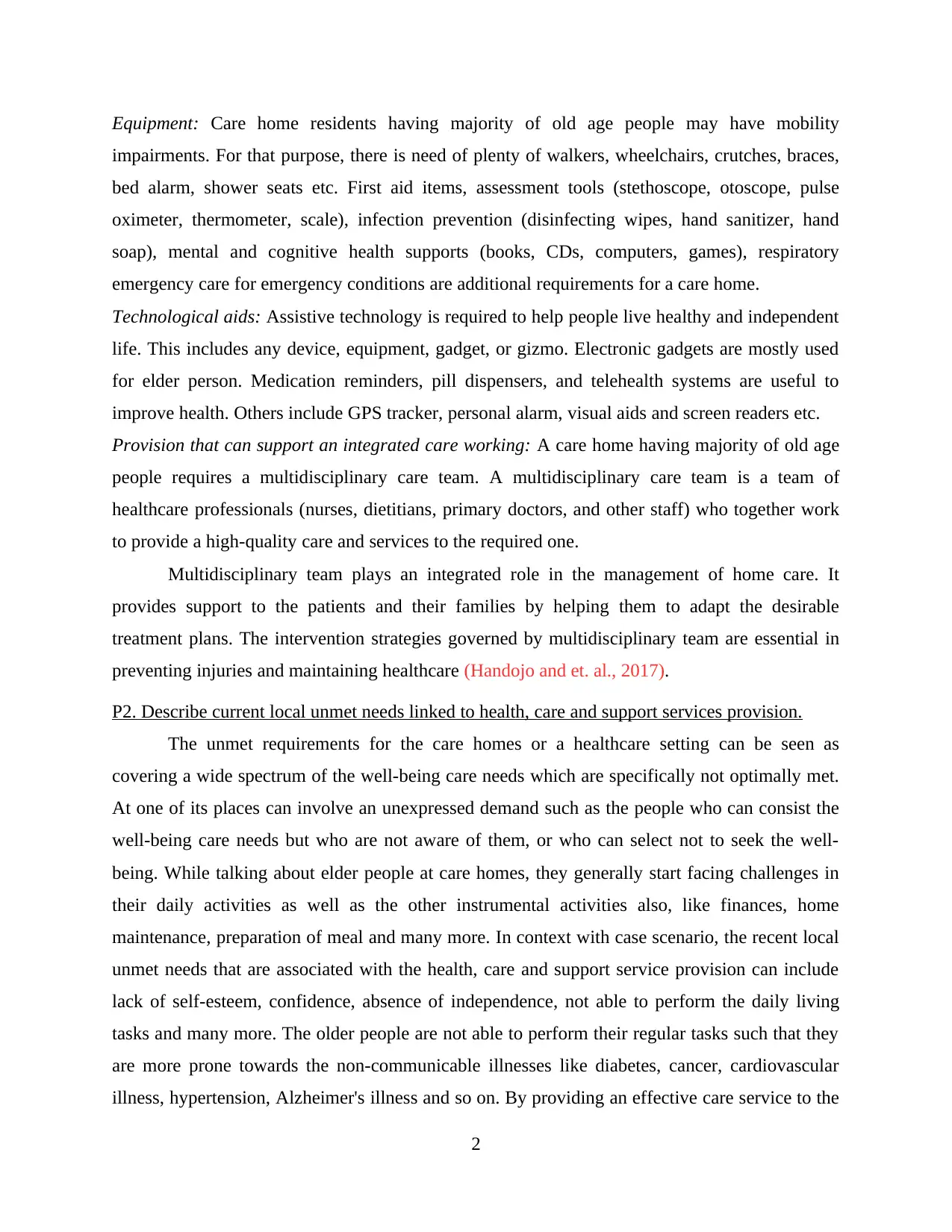
Equipment: Care home residents having majority of old age people may have mobility
impairments. For that purpose, there is need of plenty of walkers, wheelchairs, crutches, braces,
bed alarm, shower seats etc. First aid items, assessment tools (stethoscope, otoscope, pulse
oximeter, thermometer, scale), infection prevention (disinfecting wipes, hand sanitizer, hand
soap), mental and cognitive health supports (books, CDs, computers, games), respiratory
emergency care for emergency conditions are additional requirements for a care home.
Technological aids: Assistive technology is required to help people live healthy and independent
life. This includes any device, equipment, gadget, or gizmo. Electronic gadgets are mostly used
for elder person. Medication reminders, pill dispensers, and telehealth systems are useful to
improve health. Others include GPS tracker, personal alarm, visual aids and screen readers etc.
Provision that can support an integrated care working: A care home having majority of old age
people requires a multidisciplinary care team. A multidisciplinary care team is a team of
healthcare professionals (nurses, dietitians, primary doctors, and other staff) who together work
to provide a high-quality care and services to the required one.
Multidisciplinary team plays an integrated role in the management of home care. It
provides support to the patients and their families by helping them to adapt the desirable
treatment plans. The intervention strategies governed by multidisciplinary team are essential in
preventing injuries and maintaining healthcare (Handojo and et. al., 2017).
P2. Describe current local unmet needs linked to health, care and support services provision.
The unmet requirements for the care homes or a healthcare setting can be seen as
covering a wide spectrum of the well-being care needs which are specifically not optimally met.
At one of its places can involve an unexpressed demand such as the people who can consist the
well-being care needs but who are not aware of them, or who can select not to seek the well-
being. While talking about elder people at care homes, they generally start facing challenges in
their daily activities as well as the other instrumental activities also, like finances, home
maintenance, preparation of meal and many more. In context with case scenario, the recent local
unmet needs that are associated with the health, care and support service provision can include
lack of self-esteem, confidence, absence of independence, not able to perform the daily living
tasks and many more. The older people are not able to perform their regular tasks such that they
are more prone towards the non-communicable illnesses like diabetes, cancer, cardiovascular
illness, hypertension, Alzheimer's illness and so on. By providing an effective care service to the
2
impairments. For that purpose, there is need of plenty of walkers, wheelchairs, crutches, braces,
bed alarm, shower seats etc. First aid items, assessment tools (stethoscope, otoscope, pulse
oximeter, thermometer, scale), infection prevention (disinfecting wipes, hand sanitizer, hand
soap), mental and cognitive health supports (books, CDs, computers, games), respiratory
emergency care for emergency conditions are additional requirements for a care home.
Technological aids: Assistive technology is required to help people live healthy and independent
life. This includes any device, equipment, gadget, or gizmo. Electronic gadgets are mostly used
for elder person. Medication reminders, pill dispensers, and telehealth systems are useful to
improve health. Others include GPS tracker, personal alarm, visual aids and screen readers etc.
Provision that can support an integrated care working: A care home having majority of old age
people requires a multidisciplinary care team. A multidisciplinary care team is a team of
healthcare professionals (nurses, dietitians, primary doctors, and other staff) who together work
to provide a high-quality care and services to the required one.
Multidisciplinary team plays an integrated role in the management of home care. It
provides support to the patients and their families by helping them to adapt the desirable
treatment plans. The intervention strategies governed by multidisciplinary team are essential in
preventing injuries and maintaining healthcare (Handojo and et. al., 2017).
P2. Describe current local unmet needs linked to health, care and support services provision.
The unmet requirements for the care homes or a healthcare setting can be seen as
covering a wide spectrum of the well-being care needs which are specifically not optimally met.
At one of its places can involve an unexpressed demand such as the people who can consist the
well-being care needs but who are not aware of them, or who can select not to seek the well-
being. While talking about elder people at care homes, they generally start facing challenges in
their daily activities as well as the other instrumental activities also, like finances, home
maintenance, preparation of meal and many more. In context with case scenario, the recent local
unmet needs that are associated with the health, care and support service provision can include
lack of self-esteem, confidence, absence of independence, not able to perform the daily living
tasks and many more. The older people are not able to perform their regular tasks such that they
are more prone towards the non-communicable illnesses like diabetes, cancer, cardiovascular
illness, hypertension, Alzheimer's illness and so on. By providing an effective care service to the
2

older people, they can able to improve their well-being, can able to perform their daily living
tasks by effective services.
M1. Explain the difference among healthcare and social care givers and the type of inter-agency
care provision in association to meeting the needs of a person need care.
Health and social care settings are public or private centres that provide health care to
people for physical and psychological related disorders both but both experience some
dissimilarities as well. Health care givers are more concerned about increasing the longevity of
life by providing care with intent of treating the disorder. The health care system can be
bifurcated into following sectors-
Hospital care which provides care for acute disorders as well as chronic disorders. These
settings also provide care for disorders which might require long stays at the hospital
along with assistance of the nurses in the care procedure.
Health care settings which focus on providing primary care which is related to the
treatment for basic illnesses. Examples of such settings include general practitioners who
practice at their own clinic, therapists, dentists etc.
Third is the health care setting which aims at providing prophylaxis care to a large group of
people or a certain section of population (Edgar and et. al., 2020).
Social care is related to providing the patients with the assistance required for performing various
activities. These settings not only take care of the physical health but also take care of the mental
health of the patients. Social care settings are mostly used by the vulnerable individuals
belonging to the elderly group, disabled, terminally ill group etc. The work of social working
groups also come under social care as they work for supporting a section of population (although
small) to get rid of their social problems. Settings linked with free distribution of products for
promoting personal hygiene like sanitary pads also come under social care. Other than this the
people who try to minimize concerns that might affect a person's health and even people who
tries to support in terms of gender also come under the genre of social care givers (Ewing and et.
al., 2015).
D1. Evaluate the local resources and provision in terms of meeting the needs of an identified
individual need a multidisciplinary care.
The needs of an individual who requires multidisciplinary care can be met with the help
of the local resources mentioned above. Multidisciplinary care requires a lot of funds as the
3
tasks by effective services.
M1. Explain the difference among healthcare and social care givers and the type of inter-agency
care provision in association to meeting the needs of a person need care.
Health and social care settings are public or private centres that provide health care to
people for physical and psychological related disorders both but both experience some
dissimilarities as well. Health care givers are more concerned about increasing the longevity of
life by providing care with intent of treating the disorder. The health care system can be
bifurcated into following sectors-
Hospital care which provides care for acute disorders as well as chronic disorders. These
settings also provide care for disorders which might require long stays at the hospital
along with assistance of the nurses in the care procedure.
Health care settings which focus on providing primary care which is related to the
treatment for basic illnesses. Examples of such settings include general practitioners who
practice at their own clinic, therapists, dentists etc.
Third is the health care setting which aims at providing prophylaxis care to a large group of
people or a certain section of population (Edgar and et. al., 2020).
Social care is related to providing the patients with the assistance required for performing various
activities. These settings not only take care of the physical health but also take care of the mental
health of the patients. Social care settings are mostly used by the vulnerable individuals
belonging to the elderly group, disabled, terminally ill group etc. The work of social working
groups also come under social care as they work for supporting a section of population (although
small) to get rid of their social problems. Settings linked with free distribution of products for
promoting personal hygiene like sanitary pads also come under social care. Other than this the
people who try to minimize concerns that might affect a person's health and even people who
tries to support in terms of gender also come under the genre of social care givers (Ewing and et.
al., 2015).
D1. Evaluate the local resources and provision in terms of meeting the needs of an identified
individual need a multidisciplinary care.
The needs of an individual who requires multidisciplinary care can be met with the help
of the local resources mentioned above. Multidisciplinary care requires a lot of funds as the
3
⊘ This is a preview!⊘
Do you want full access?
Subscribe today to unlock all pages.

Trusted by 1+ million students worldwide
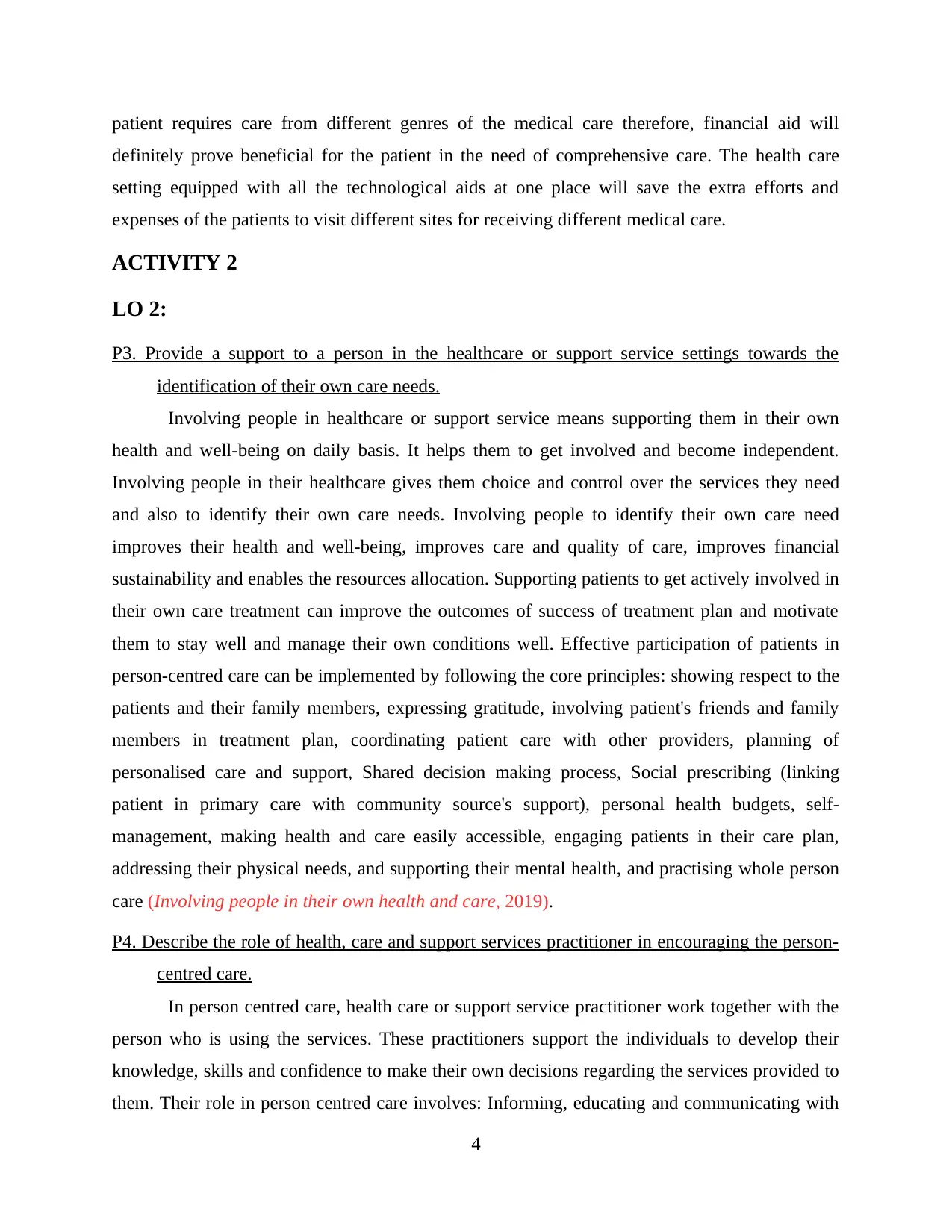
patient requires care from different genres of the medical care therefore, financial aid will
definitely prove beneficial for the patient in the need of comprehensive care. The health care
setting equipped with all the technological aids at one place will save the extra efforts and
expenses of the patients to visit different sites for receiving different medical care.
ACTIVITY 2
LO 2:
P3. Provide a support to a person in the healthcare or support service settings towards the
identification of their own care needs.
Involving people in healthcare or support service means supporting them in their own
health and well-being on daily basis. It helps them to get involved and become independent.
Involving people in their healthcare gives them choice and control over the services they need
and also to identify their own care needs. Involving people to identify their own care need
improves their health and well-being, improves care and quality of care, improves financial
sustainability and enables the resources allocation. Supporting patients to get actively involved in
their own care treatment can improve the outcomes of success of treatment plan and motivate
them to stay well and manage their own conditions well. Effective participation of patients in
person-centred care can be implemented by following the core principles: showing respect to the
patients and their family members, expressing gratitude, involving patient's friends and family
members in treatment plan, coordinating patient care with other providers, planning of
personalised care and support, Shared decision making process, Social prescribing (linking
patient in primary care with community source's support), personal health budgets, self-
management, making health and care easily accessible, engaging patients in their care plan,
addressing their physical needs, and supporting their mental health, and practising whole person
care (Involving people in their own health and care, 2019).
P4. Describe the role of health, care and support services practitioner in encouraging the person-
centred care.
In person centred care, health care or support service practitioner work together with the
person who is using the services. These practitioners support the individuals to develop their
knowledge, skills and confidence to make their own decisions regarding the services provided to
them. Their role in person centred care involves: Informing, educating and communicating with
4
definitely prove beneficial for the patient in the need of comprehensive care. The health care
setting equipped with all the technological aids at one place will save the extra efforts and
expenses of the patients to visit different sites for receiving different medical care.
ACTIVITY 2
LO 2:
P3. Provide a support to a person in the healthcare or support service settings towards the
identification of their own care needs.
Involving people in healthcare or support service means supporting them in their own
health and well-being on daily basis. It helps them to get involved and become independent.
Involving people in their healthcare gives them choice and control over the services they need
and also to identify their own care needs. Involving people to identify their own care need
improves their health and well-being, improves care and quality of care, improves financial
sustainability and enables the resources allocation. Supporting patients to get actively involved in
their own care treatment can improve the outcomes of success of treatment plan and motivate
them to stay well and manage their own conditions well. Effective participation of patients in
person-centred care can be implemented by following the core principles: showing respect to the
patients and their family members, expressing gratitude, involving patient's friends and family
members in treatment plan, coordinating patient care with other providers, planning of
personalised care and support, Shared decision making process, Social prescribing (linking
patient in primary care with community source's support), personal health budgets, self-
management, making health and care easily accessible, engaging patients in their care plan,
addressing their physical needs, and supporting their mental health, and practising whole person
care (Involving people in their own health and care, 2019).
P4. Describe the role of health, care and support services practitioner in encouraging the person-
centred care.
In person centred care, health care or support service practitioner work together with the
person who is using the services. These practitioners support the individuals to develop their
knowledge, skills and confidence to make their own decisions regarding the services provided to
them. Their role in person centred care involves: Informing, educating and communicating with
4
Paraphrase This Document
Need a fresh take? Get an instant paraphrase of this document with our AI Paraphraser
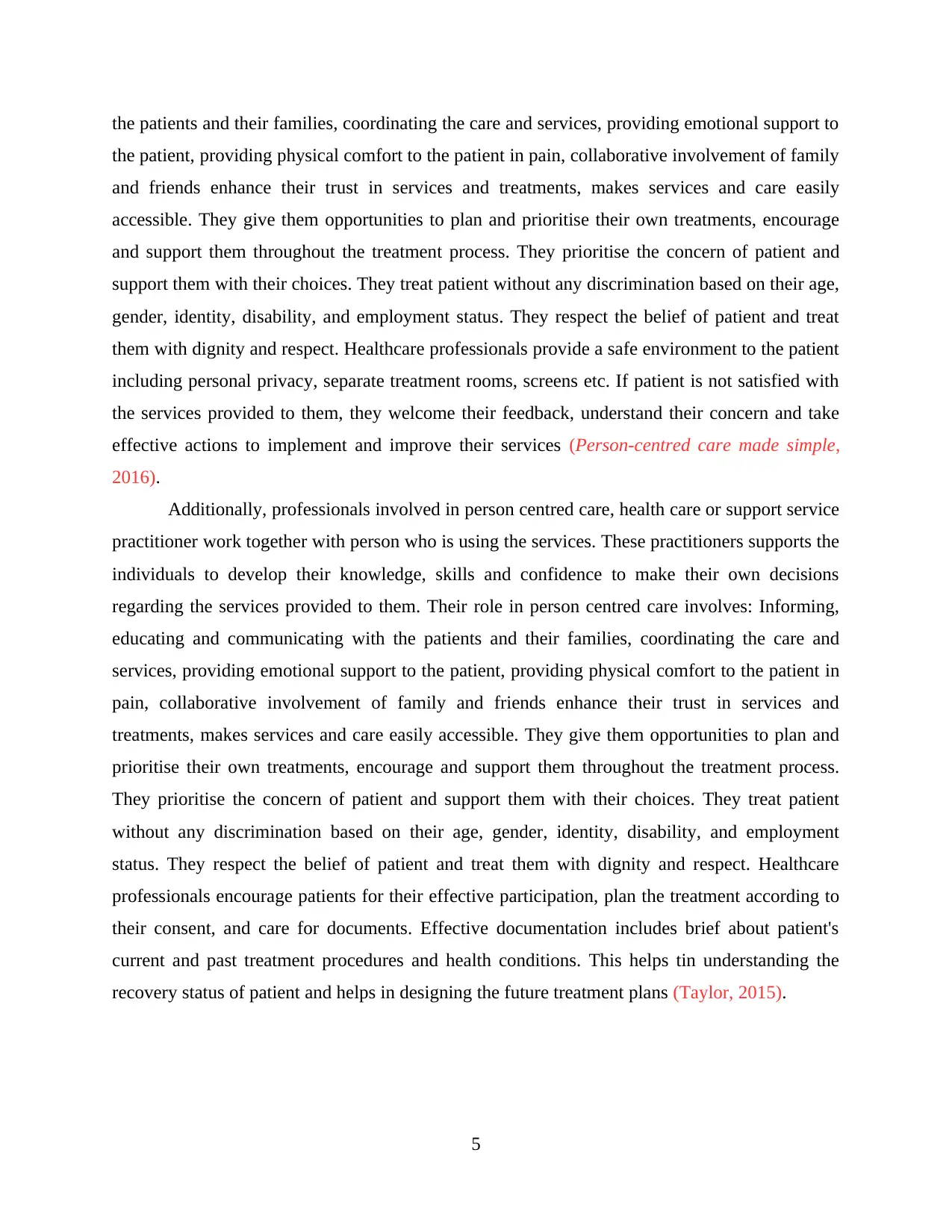
the patients and their families, coordinating the care and services, providing emotional support to
the patient, providing physical comfort to the patient in pain, collaborative involvement of family
and friends enhance their trust in services and treatments, makes services and care easily
accessible. They give them opportunities to plan and prioritise their own treatments, encourage
and support them throughout the treatment process. They prioritise the concern of patient and
support them with their choices. They treat patient without any discrimination based on their age,
gender, identity, disability, and employment status. They respect the belief of patient and treat
them with dignity and respect. Healthcare professionals provide a safe environment to the patient
including personal privacy, separate treatment rooms, screens etc. If patient is not satisfied with
the services provided to them, they welcome their feedback, understand their concern and take
effective actions to implement and improve their services (Person-centred care made simple,
2016).
Additionally, professionals involved in person centred care, health care or support service
practitioner work together with person who is using the services. These practitioners supports the
individuals to develop their knowledge, skills and confidence to make their own decisions
regarding the services provided to them. Their role in person centred care involves: Informing,
educating and communicating with the patients and their families, coordinating the care and
services, providing emotional support to the patient, providing physical comfort to the patient in
pain, collaborative involvement of family and friends enhance their trust in services and
treatments, makes services and care easily accessible. They give them opportunities to plan and
prioritise their own treatments, encourage and support them throughout the treatment process.
They prioritise the concern of patient and support them with their choices. They treat patient
without any discrimination based on their age, gender, identity, disability, and employment
status. They respect the belief of patient and treat them with dignity and respect. Healthcare
professionals encourage patients for their effective participation, plan the treatment according to
their consent, and care for documents. Effective documentation includes brief about patient's
current and past treatment procedures and health conditions. This helps tin understanding the
recovery status of patient and helps in designing the future treatment plans (Taylor, 2015).
5
the patient, providing physical comfort to the patient in pain, collaborative involvement of family
and friends enhance their trust in services and treatments, makes services and care easily
accessible. They give them opportunities to plan and prioritise their own treatments, encourage
and support them throughout the treatment process. They prioritise the concern of patient and
support them with their choices. They treat patient without any discrimination based on their age,
gender, identity, disability, and employment status. They respect the belief of patient and treat
them with dignity and respect. Healthcare professionals provide a safe environment to the patient
including personal privacy, separate treatment rooms, screens etc. If patient is not satisfied with
the services provided to them, they welcome their feedback, understand their concern and take
effective actions to implement and improve their services (Person-centred care made simple,
2016).
Additionally, professionals involved in person centred care, health care or support service
practitioner work together with person who is using the services. These practitioners supports the
individuals to develop their knowledge, skills and confidence to make their own decisions
regarding the services provided to them. Their role in person centred care involves: Informing,
educating and communicating with the patients and their families, coordinating the care and
services, providing emotional support to the patient, providing physical comfort to the patient in
pain, collaborative involvement of family and friends enhance their trust in services and
treatments, makes services and care easily accessible. They give them opportunities to plan and
prioritise their own treatments, encourage and support them throughout the treatment process.
They prioritise the concern of patient and support them with their choices. They treat patient
without any discrimination based on their age, gender, identity, disability, and employment
status. They respect the belief of patient and treat them with dignity and respect. Healthcare
professionals encourage patients for their effective participation, plan the treatment according to
their consent, and care for documents. Effective documentation includes brief about patient's
current and past treatment procedures and health conditions. This helps tin understanding the
recovery status of patient and helps in designing the future treatment plans (Taylor, 2015).
5
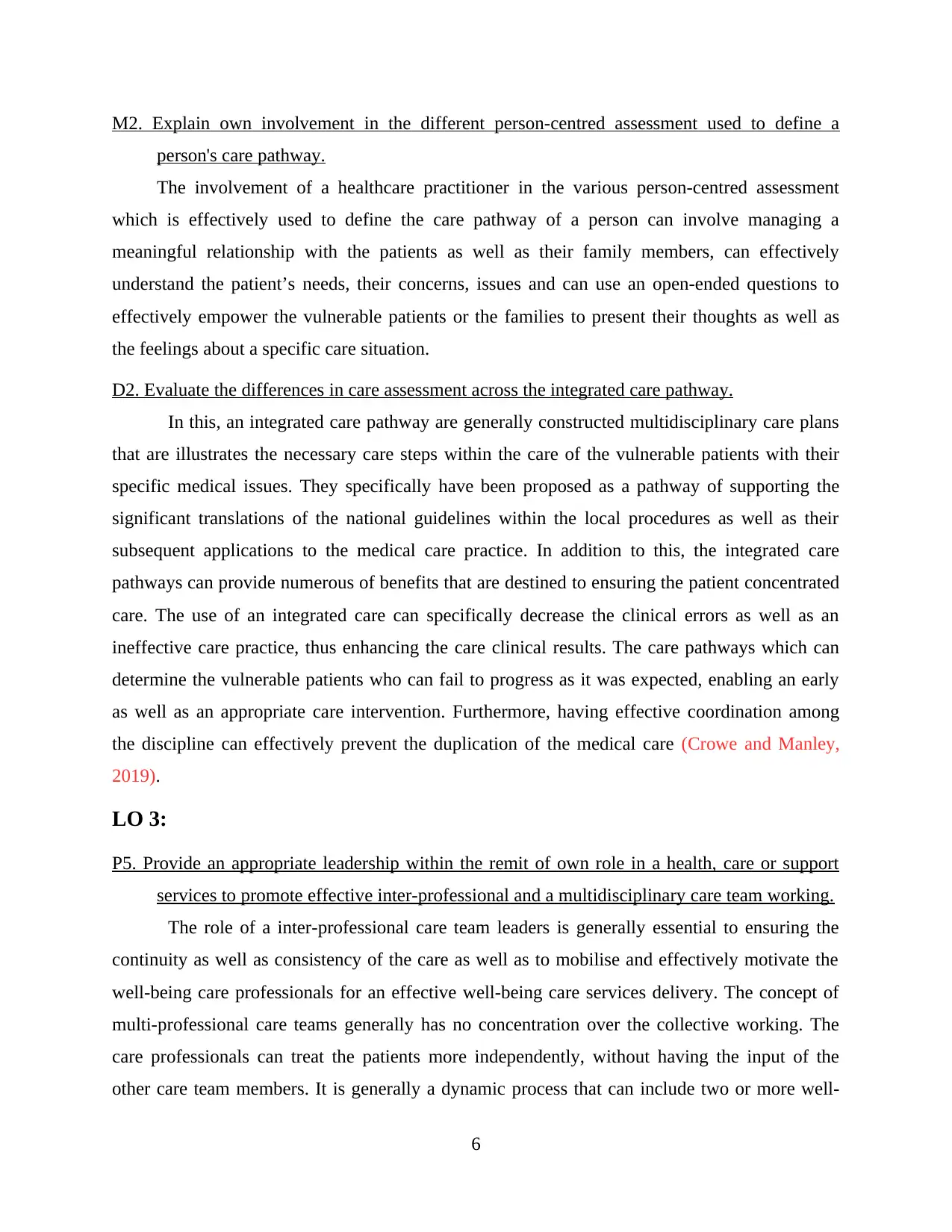
M2. Explain own involvement in the different person-centred assessment used to define a
person's care pathway.
The involvement of a healthcare practitioner in the various person-centred assessment
which is effectively used to define the care pathway of a person can involve managing a
meaningful relationship with the patients as well as their family members, can effectively
understand the patient’s needs, their concerns, issues and can use an open-ended questions to
effectively empower the vulnerable patients or the families to present their thoughts as well as
the feelings about a specific care situation.
D2. Evaluate the differences in care assessment across the integrated care pathway.
In this, an integrated care pathway are generally constructed multidisciplinary care plans
that are illustrates the necessary care steps within the care of the vulnerable patients with their
specific medical issues. They specifically have been proposed as a pathway of supporting the
significant translations of the national guidelines within the local procedures as well as their
subsequent applications to the medical care practice. In addition to this, the integrated care
pathways can provide numerous of benefits that are destined to ensuring the patient concentrated
care. The use of an integrated care can specifically decrease the clinical errors as well as an
ineffective care practice, thus enhancing the care clinical results. The care pathways which can
determine the vulnerable patients who can fail to progress as it was expected, enabling an early
as well as an appropriate care intervention. Furthermore, having effective coordination among
the discipline can effectively prevent the duplication of the medical care (Crowe and Manley,
2019).
LO 3:
P5. Provide an appropriate leadership within the remit of own role in a health, care or support
services to promote effective inter-professional and a multidisciplinary care team working.
The role of a inter-professional care team leaders is generally essential to ensuring the
continuity as well as consistency of the care as well as to mobilise and effectively motivate the
well-being care professionals for an effective well-being care services delivery. The concept of
multi-professional care teams generally has no concentration over the collective working. The
care professionals can treat the patients more independently, without having the input of the
other care team members. It is generally a dynamic process that can include two or more well-
6
person's care pathway.
The involvement of a healthcare practitioner in the various person-centred assessment
which is effectively used to define the care pathway of a person can involve managing a
meaningful relationship with the patients as well as their family members, can effectively
understand the patient’s needs, their concerns, issues and can use an open-ended questions to
effectively empower the vulnerable patients or the families to present their thoughts as well as
the feelings about a specific care situation.
D2. Evaluate the differences in care assessment across the integrated care pathway.
In this, an integrated care pathway are generally constructed multidisciplinary care plans
that are illustrates the necessary care steps within the care of the vulnerable patients with their
specific medical issues. They specifically have been proposed as a pathway of supporting the
significant translations of the national guidelines within the local procedures as well as their
subsequent applications to the medical care practice. In addition to this, the integrated care
pathways can provide numerous of benefits that are destined to ensuring the patient concentrated
care. The use of an integrated care can specifically decrease the clinical errors as well as an
ineffective care practice, thus enhancing the care clinical results. The care pathways which can
determine the vulnerable patients who can fail to progress as it was expected, enabling an early
as well as an appropriate care intervention. Furthermore, having effective coordination among
the discipline can effectively prevent the duplication of the medical care (Crowe and Manley,
2019).
LO 3:
P5. Provide an appropriate leadership within the remit of own role in a health, care or support
services to promote effective inter-professional and a multidisciplinary care team working.
The role of a inter-professional care team leaders is generally essential to ensuring the
continuity as well as consistency of the care as well as to mobilise and effectively motivate the
well-being care professionals for an effective well-being care services delivery. The concept of
multi-professional care teams generally has no concentration over the collective working. The
care professionals can treat the patients more independently, without having the input of the
other care team members. It is generally a dynamic process that can include two or more well-
6
⊘ This is a preview!⊘
Do you want full access?
Subscribe today to unlock all pages.

Trusted by 1+ million students worldwide
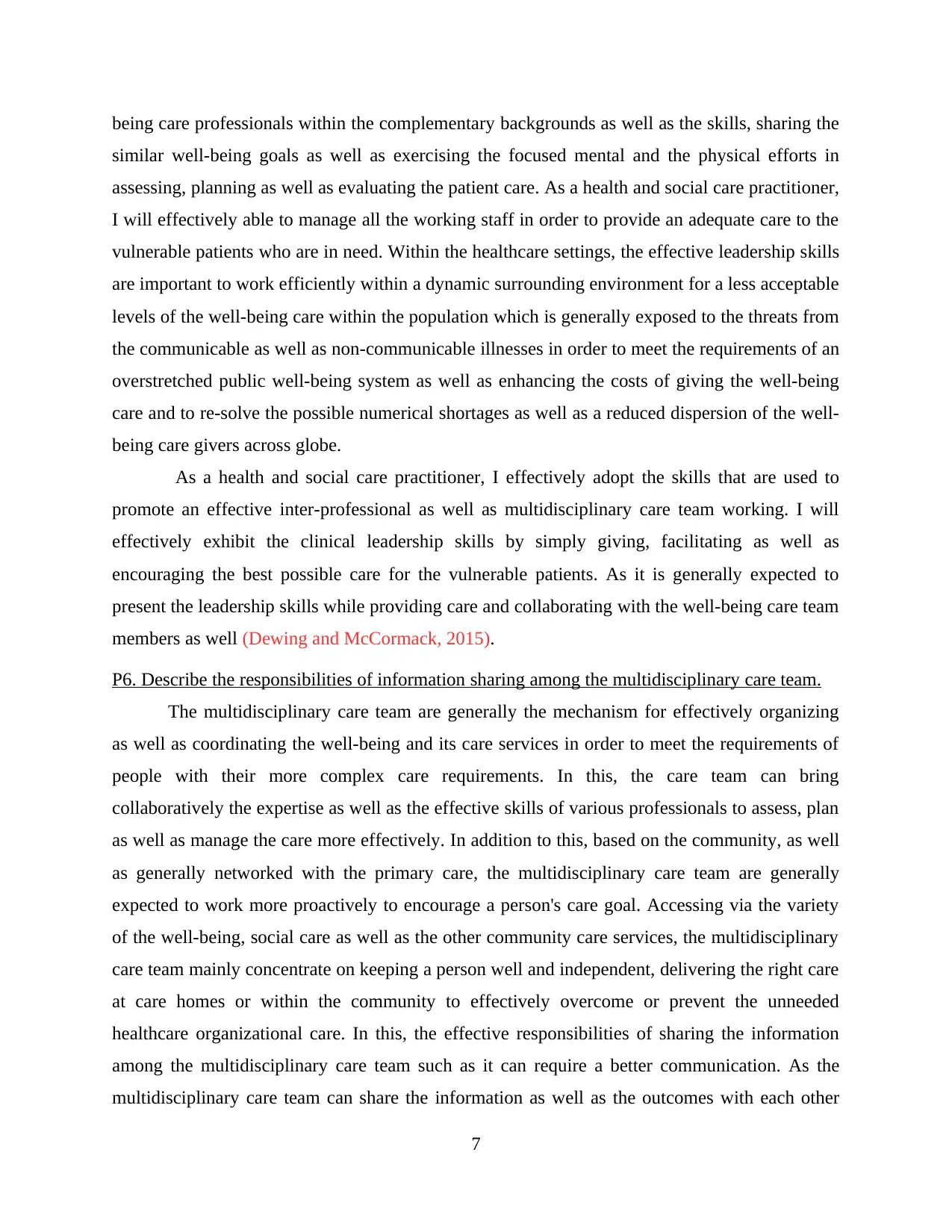
being care professionals within the complementary backgrounds as well as the skills, sharing the
similar well-being goals as well as exercising the focused mental and the physical efforts in
assessing, planning as well as evaluating the patient care. As a health and social care practitioner,
I will effectively able to manage all the working staff in order to provide an adequate care to the
vulnerable patients who are in need. Within the healthcare settings, the effective leadership skills
are important to work efficiently within a dynamic surrounding environment for a less acceptable
levels of the well-being care within the population which is generally exposed to the threats from
the communicable as well as non-communicable illnesses in order to meet the requirements of an
overstretched public well-being system as well as enhancing the costs of giving the well-being
care and to re-solve the possible numerical shortages as well as a reduced dispersion of the well-
being care givers across globe.
As a health and social care practitioner, I effectively adopt the skills that are used to
promote an effective inter-professional as well as multidisciplinary care team working. I will
effectively exhibit the clinical leadership skills by simply giving, facilitating as well as
encouraging the best possible care for the vulnerable patients. As it is generally expected to
present the leadership skills while providing care and collaborating with the well-being care team
members as well (Dewing and McCormack, 2015).
P6. Describe the responsibilities of information sharing among the multidisciplinary care team.
The multidisciplinary care team are generally the mechanism for effectively organizing
as well as coordinating the well-being and its care services in order to meet the requirements of
people with their more complex care requirements. In this, the care team can bring
collaboratively the expertise as well as the effective skills of various professionals to assess, plan
as well as manage the care more effectively. In addition to this, based on the community, as well
as generally networked with the primary care, the multidisciplinary care team are generally
expected to work more proactively to encourage a person's care goal. Accessing via the variety
of the well-being, social care as well as the other community care services, the multidisciplinary
care team mainly concentrate on keeping a person well and independent, delivering the right care
at care homes or within the community to effectively overcome or prevent the unneeded
healthcare organizational care. In this, the effective responsibilities of sharing the information
among the multidisciplinary care team such as it can require a better communication. As the
multidisciplinary care team can share the information as well as the outcomes with each other
7
similar well-being goals as well as exercising the focused mental and the physical efforts in
assessing, planning as well as evaluating the patient care. As a health and social care practitioner,
I will effectively able to manage all the working staff in order to provide an adequate care to the
vulnerable patients who are in need. Within the healthcare settings, the effective leadership skills
are important to work efficiently within a dynamic surrounding environment for a less acceptable
levels of the well-being care within the population which is generally exposed to the threats from
the communicable as well as non-communicable illnesses in order to meet the requirements of an
overstretched public well-being system as well as enhancing the costs of giving the well-being
care and to re-solve the possible numerical shortages as well as a reduced dispersion of the well-
being care givers across globe.
As a health and social care practitioner, I effectively adopt the skills that are used to
promote an effective inter-professional as well as multidisciplinary care team working. I will
effectively exhibit the clinical leadership skills by simply giving, facilitating as well as
encouraging the best possible care for the vulnerable patients. As it is generally expected to
present the leadership skills while providing care and collaborating with the well-being care team
members as well (Dewing and McCormack, 2015).
P6. Describe the responsibilities of information sharing among the multidisciplinary care team.
The multidisciplinary care team are generally the mechanism for effectively organizing
as well as coordinating the well-being and its care services in order to meet the requirements of
people with their more complex care requirements. In this, the care team can bring
collaboratively the expertise as well as the effective skills of various professionals to assess, plan
as well as manage the care more effectively. In addition to this, based on the community, as well
as generally networked with the primary care, the multidisciplinary care team are generally
expected to work more proactively to encourage a person's care goal. Accessing via the variety
of the well-being, social care as well as the other community care services, the multidisciplinary
care team mainly concentrate on keeping a person well and independent, delivering the right care
at care homes or within the community to effectively overcome or prevent the unneeded
healthcare organizational care. In this, the effective responsibilities of sharing the information
among the multidisciplinary care team such as it can require a better communication. As the
multidisciplinary care team can share the information as well as the outcomes with each other
7
Paraphrase This Document
Need a fresh take? Get an instant paraphrase of this document with our AI Paraphraser
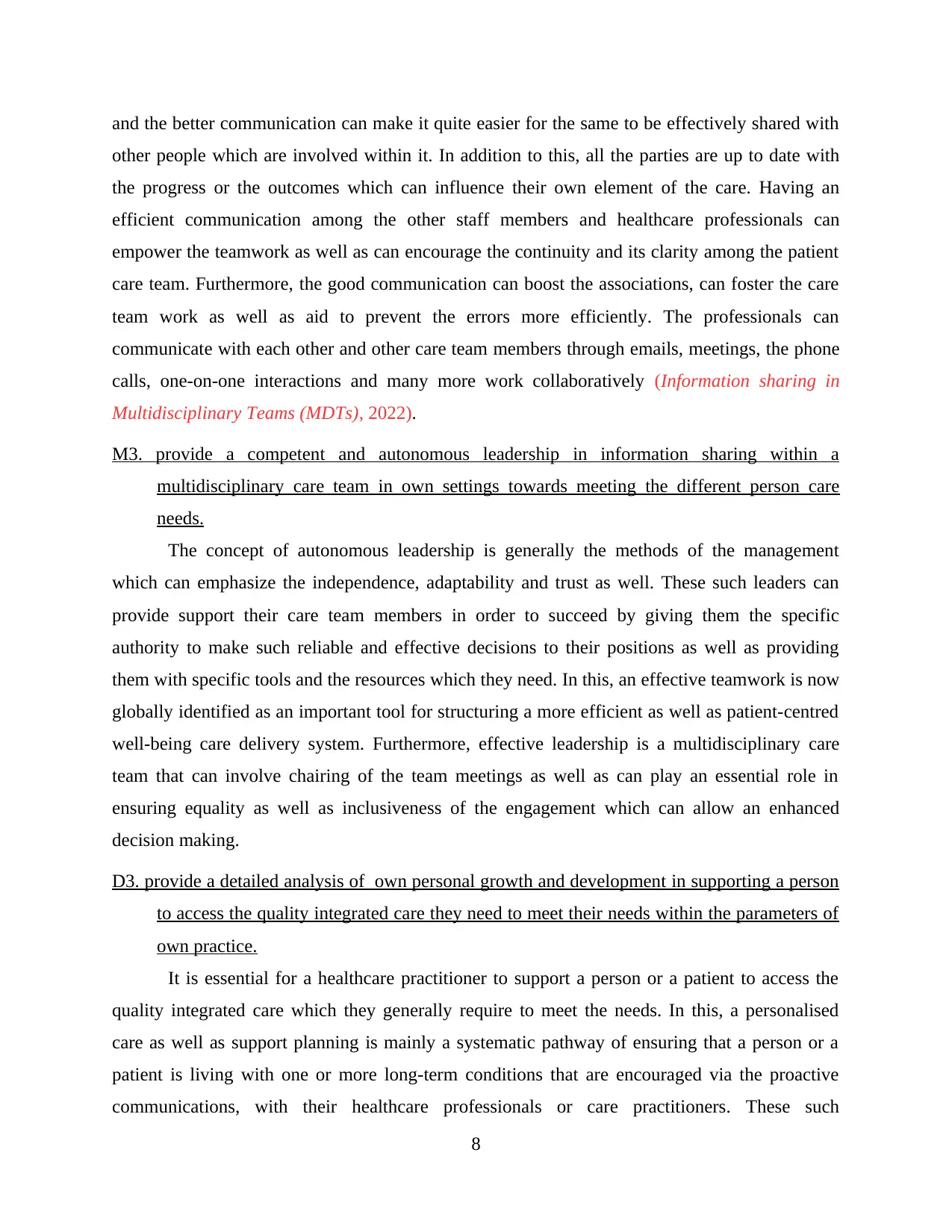
and the better communication can make it quite easier for the same to be effectively shared with
other people which are involved within it. In addition to this, all the parties are up to date with
the progress or the outcomes which can influence their own element of the care. Having an
efficient communication among the other staff members and healthcare professionals can
empower the teamwork as well as can encourage the continuity and its clarity among the patient
care team. Furthermore, the good communication can boost the associations, can foster the care
team work as well as aid to prevent the errors more efficiently. The professionals can
communicate with each other and other care team members through emails, meetings, the phone
calls, one-on-one interactions and many more work collaboratively (Information sharing in
Multidisciplinary Teams (MDTs), 2022).
M3. provide a competent and autonomous leadership in information sharing within a
multidisciplinary care team in own settings towards meeting the different person care
needs.
The concept of autonomous leadership is generally the methods of the management
which can emphasize the independence, adaptability and trust as well. These such leaders can
provide support their care team members in order to succeed by giving them the specific
authority to make such reliable and effective decisions to their positions as well as providing
them with specific tools and the resources which they need. In this, an effective teamwork is now
globally identified as an important tool for structuring a more efficient as well as patient-centred
well-being care delivery system. Furthermore, effective leadership is a multidisciplinary care
team that can involve chairing of the team meetings as well as can play an essential role in
ensuring equality as well as inclusiveness of the engagement which can allow an enhanced
decision making.
D3. provide a detailed analysis of own personal growth and development in supporting a person
to access the quality integrated care they need to meet their needs within the parameters of
own practice.
It is essential for a healthcare practitioner to support a person or a patient to access the
quality integrated care which they generally require to meet the needs. In this, a personalised
care as well as support planning is mainly a systematic pathway of ensuring that a person or a
patient is living with one or more long-term conditions that are encouraged via the proactive
communications, with their healthcare professionals or care practitioners. These such
8
other people which are involved within it. In addition to this, all the parties are up to date with
the progress or the outcomes which can influence their own element of the care. Having an
efficient communication among the other staff members and healthcare professionals can
empower the teamwork as well as can encourage the continuity and its clarity among the patient
care team. Furthermore, the good communication can boost the associations, can foster the care
team work as well as aid to prevent the errors more efficiently. The professionals can
communicate with each other and other care team members through emails, meetings, the phone
calls, one-on-one interactions and many more work collaboratively (Information sharing in
Multidisciplinary Teams (MDTs), 2022).
M3. provide a competent and autonomous leadership in information sharing within a
multidisciplinary care team in own settings towards meeting the different person care
needs.
The concept of autonomous leadership is generally the methods of the management
which can emphasize the independence, adaptability and trust as well. These such leaders can
provide support their care team members in order to succeed by giving them the specific
authority to make such reliable and effective decisions to their positions as well as providing
them with specific tools and the resources which they need. In this, an effective teamwork is now
globally identified as an important tool for structuring a more efficient as well as patient-centred
well-being care delivery system. Furthermore, effective leadership is a multidisciplinary care
team that can involve chairing of the team meetings as well as can play an essential role in
ensuring equality as well as inclusiveness of the engagement which can allow an enhanced
decision making.
D3. provide a detailed analysis of own personal growth and development in supporting a person
to access the quality integrated care they need to meet their needs within the parameters of
own practice.
It is essential for a healthcare practitioner to support a person or a patient to access the
quality integrated care which they generally require to meet the needs. In this, a personalised
care as well as support planning is mainly a systematic pathway of ensuring that a person or a
patient is living with one or more long-term conditions that are encouraged via the proactive
communications, with their healthcare professionals or care practitioners. These such
8
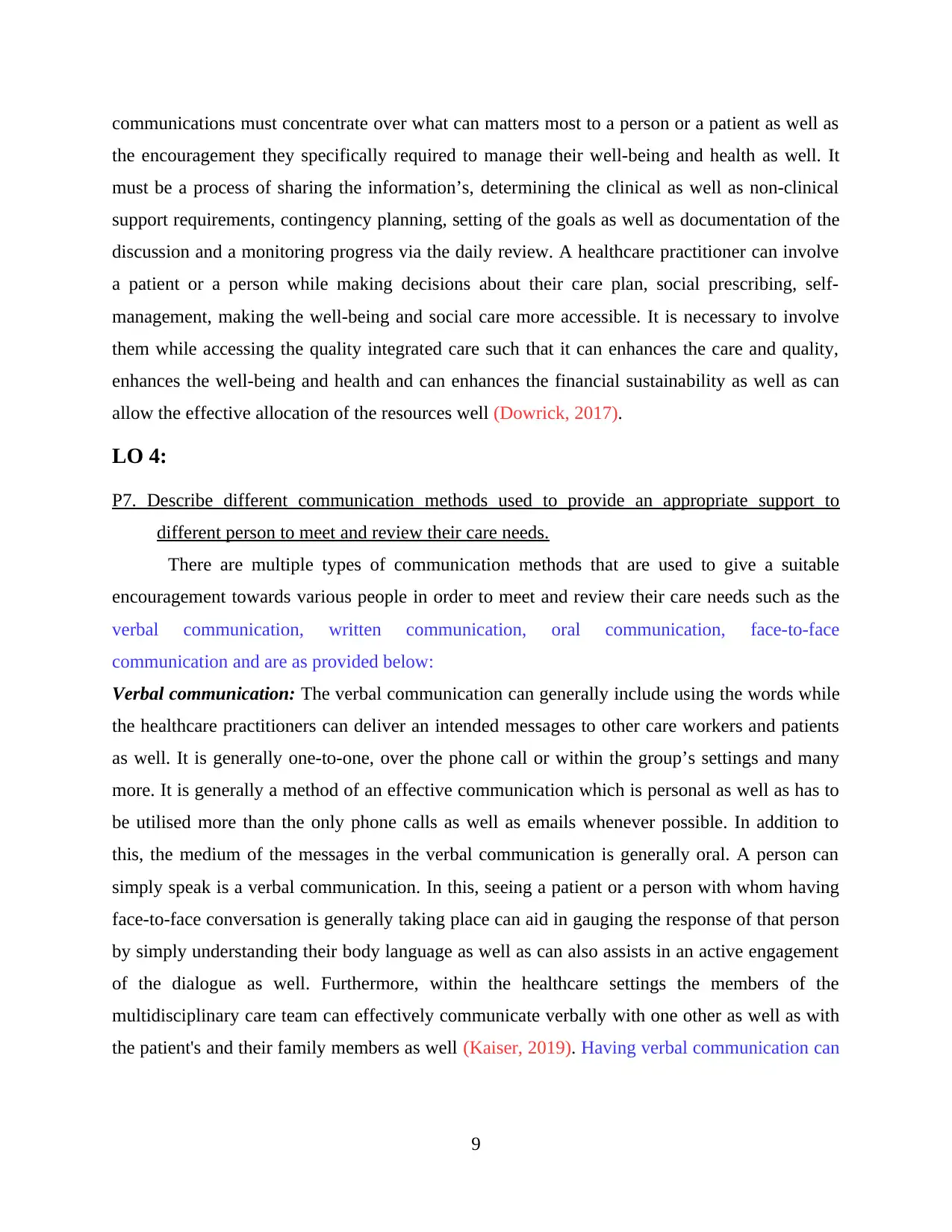
communications must concentrate over what can matters most to a person or a patient as well as
the encouragement they specifically required to manage their well-being and health as well. It
must be a process of sharing the information’s, determining the clinical as well as non-clinical
support requirements, contingency planning, setting of the goals as well as documentation of the
discussion and a monitoring progress via the daily review. A healthcare practitioner can involve
a patient or a person while making decisions about their care plan, social prescribing, self-
management, making the well-being and social care more accessible. It is necessary to involve
them while accessing the quality integrated care such that it can enhances the care and quality,
enhances the well-being and health and can enhances the financial sustainability as well as can
allow the effective allocation of the resources well (Dowrick, 2017).
LO 4:
P7. Describe different communication methods used to provide an appropriate support to
different person to meet and review their care needs.
There are multiple types of communication methods that are used to give a suitable
encouragement towards various people in order to meet and review their care needs such as the
verbal communication, written communication, oral communication, face-to-face
communication and are as provided below:
Verbal communication: The verbal communication can generally include using the words while
the healthcare practitioners can deliver an intended messages to other care workers and patients
as well. It is generally one-to-one, over the phone call or within the group’s settings and many
more. It is generally a method of an effective communication which is personal as well as has to
be utilised more than the only phone calls as well as emails whenever possible. In addition to
this, the medium of the messages in the verbal communication is generally oral. A person can
simply speak is a verbal communication. In this, seeing a patient or a person with whom having
face-to-face conversation is generally taking place can aid in gauging the response of that person
by simply understanding their body language as well as can also assists in an active engagement
of the dialogue as well. Furthermore, within the healthcare settings the members of the
multidisciplinary care team can effectively communicate verbally with one other as well as with
the patient's and their family members as well (Kaiser, 2019). Having verbal communication can
9
the encouragement they specifically required to manage their well-being and health as well. It
must be a process of sharing the information’s, determining the clinical as well as non-clinical
support requirements, contingency planning, setting of the goals as well as documentation of the
discussion and a monitoring progress via the daily review. A healthcare practitioner can involve
a patient or a person while making decisions about their care plan, social prescribing, self-
management, making the well-being and social care more accessible. It is necessary to involve
them while accessing the quality integrated care such that it can enhances the care and quality,
enhances the well-being and health and can enhances the financial sustainability as well as can
allow the effective allocation of the resources well (Dowrick, 2017).
LO 4:
P7. Describe different communication methods used to provide an appropriate support to
different person to meet and review their care needs.
There are multiple types of communication methods that are used to give a suitable
encouragement towards various people in order to meet and review their care needs such as the
verbal communication, written communication, oral communication, face-to-face
communication and are as provided below:
Verbal communication: The verbal communication can generally include using the words while
the healthcare practitioners can deliver an intended messages to other care workers and patients
as well. It is generally one-to-one, over the phone call or within the group’s settings and many
more. It is generally a method of an effective communication which is personal as well as has to
be utilised more than the only phone calls as well as emails whenever possible. In addition to
this, the medium of the messages in the verbal communication is generally oral. A person can
simply speak is a verbal communication. In this, seeing a patient or a person with whom having
face-to-face conversation is generally taking place can aid in gauging the response of that person
by simply understanding their body language as well as can also assists in an active engagement
of the dialogue as well. Furthermore, within the healthcare settings the members of the
multidisciplinary care team can effectively communicate verbally with one other as well as with
the patient's and their family members as well (Kaiser, 2019). Having verbal communication can
9
⊘ This is a preview!⊘
Do you want full access?
Subscribe today to unlock all pages.

Trusted by 1+ million students worldwide
1 out of 18
Related Documents
Your All-in-One AI-Powered Toolkit for Academic Success.
+13062052269
info@desklib.com
Available 24*7 on WhatsApp / Email
![[object Object]](/_next/static/media/star-bottom.7253800d.svg)
Unlock your academic potential
Copyright © 2020–2025 A2Z Services. All Rights Reserved. Developed and managed by ZUCOL.





